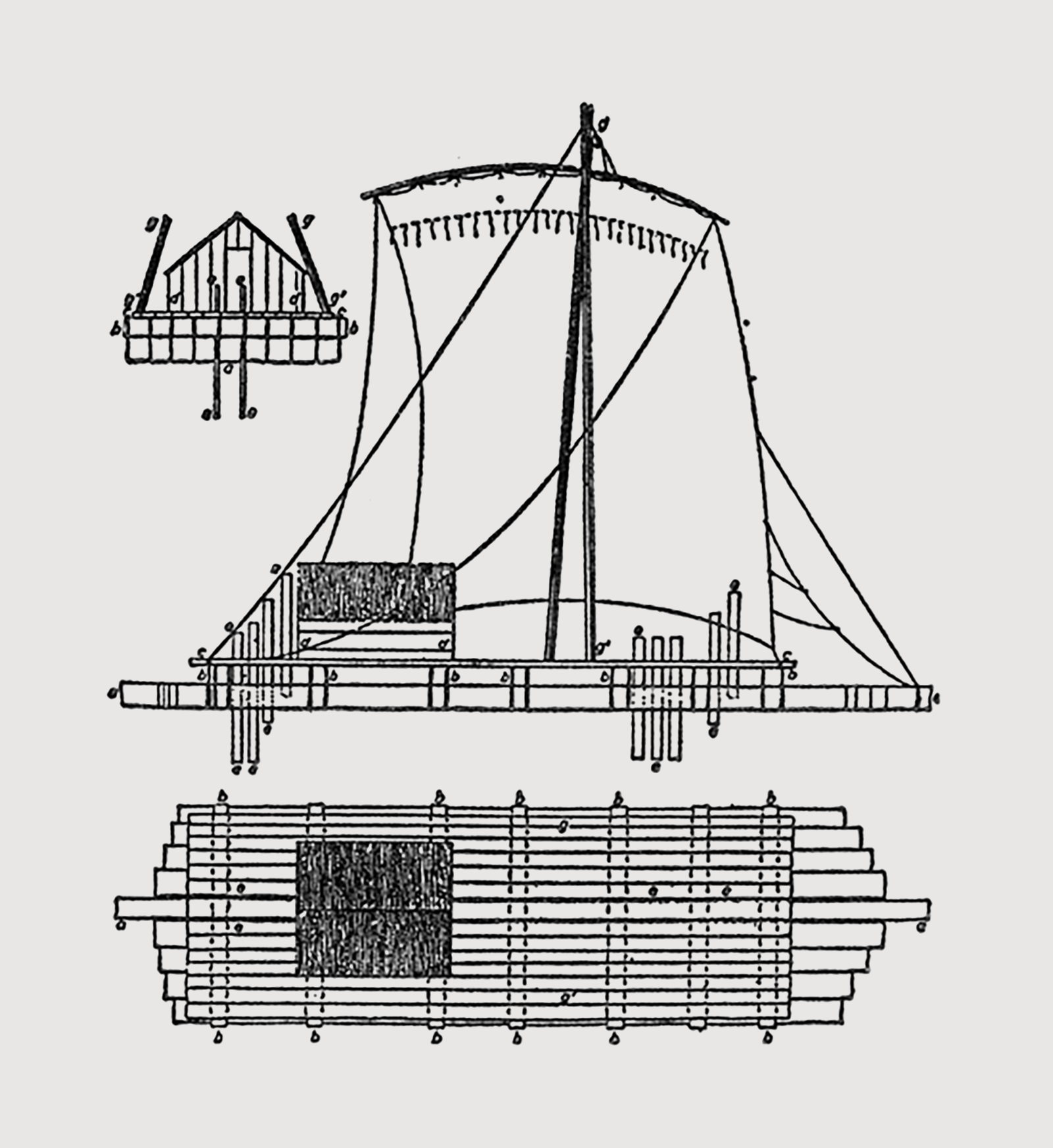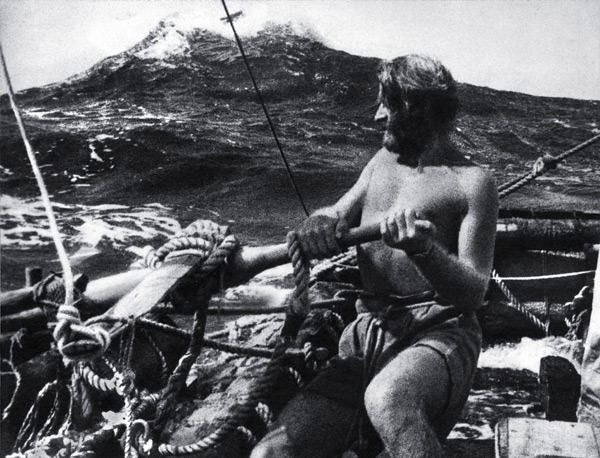|
|
|
| GGG managers are SunkenCiv, StayAt HomeMother & Ernest_at_the_Beach | |

|
|
Thanks Theoria. |
|
|
|
|
Posted on 02/08/2012 7:20:56 AM PST by Theoria
The scattered islands of the vast Pacific Ocean were settled by seafarers who set out from the eastern coasts and islands of Asia and traveled thousands of kilometers by boat. Meanwhile pre-Columbian South America was populated by people who crossed a now-vanished land bridge far to the north. Did these two groups ever meet in the New World? There's a good chance of that, according to a new study, which finds evidence that Easter Islanders may have reached South America and mixed with the Native Americans already there.
University of Oslo immunologist Erik Thorsby first began analyzing the people of Easter Island in 1971 to see if he and colleagues could detect traces of an early contribution of Native Americans to Polynesians. He believes that his recent finds may show that Native Americans may have accompanied Polynesians from the coast of South America to Easter Island before the arrival of Europeans.
The island, also called Rapa Nui, is a remote and rocky place 3700 kilometers west of the coast of South America. The people were forcibly deported to Peru in the 1860s and enslaved; therefore, evidence of mixed Polynesian and Native American genes may stem from this time. But Thorsby was able to use blood samples from the islanders, collected since the 1970s, to examine their DNA for particular genetic markers.
As expected, the majority of markers pointed to genes common in other Polynesians. But human leukocyte antigens—a group of genes that encode proteins essential to the human immune system—in the samples showed that a few individuals had a type, or allele, found among only Native Americans. The alleles in question were found on two different haplotypes—a set of alleles inherited by an individual from a single parent—in unrelated individuals. This and other circumstantial genetic evidence suggests that the alleles are older and were introduced centuries before the islanders were sent to Peru by Europeans, Thorsby reports today in the Philosophical Transactions of the Royal Society B. "The results of our studies suggest that Polynesians visiting South America in the 1400s to 1500s may have taken some American Indians with them upon their return" back to Easter Island, he said in an e-mail from there, where he is conducting further research. That conclusion, he adds, is "speculative."
Scholars have seen some other hints of contact between Polynesians and the people of the New World. Some plants, such as the sweet potato, originated in the Andes Mountains but apparently spread across the Pacific Ocean before the arrival of Columbus. Researchers have noted hints of linguistic and artistic similarities between the western South American and the Polynesian culture. But definitive archaeological evidence is lacking. Finding genetic proof of Native American and Polynesian mixing prior to Columbus's arrival in the New World in 1492 would demonstrate that Polynesians had the capacity to reach South America.
Still, Thorsby's assertion is being greeted with polite skepticism from one scholar familiar with Easter Island's past. "It is good to see this kind of research, but a definitive answer isn't really possible given the lack of chronological control," says archaeologist Terry Hunt of the University of Hawaii, Manoa, who has worked extensively on the island. He says that Thorsby's data don't preclude the possibility that the mixing between these groups occurred later, after Europeans arrived. "Native American genes reaching Rapa Nui with European contact cannot be ruled out." He says what's needed to prove the theory are skeletons that predate the European arrival in 1722. But so far, most of the few remains seem to be later. "The odds are not great" of finding ancient human bones that might yield DNA, he adds. Thorsby acknowledges that more DNA studies of ancient material are needed but remains hopeful that he can clinch the case.
T.Heyerdahl shocked, surprised /s. ping.
“Men Out of Asia” by Gladwin speculated, back in the 40s, that Central and South America were reached by people out of the Pacific (and he even tought that remnants of Alexander the Great’s fleet were among them). Fascinating (albeit highly speculative) book. It makes sense to me that if Polynesians (and Melanesians?) could populate tiny islands far out in the Pacific, then some number of them would have made it all the way to the Americas.
India, Southeast Asia and Australia appear to have been populated by coast and island skipping out of Africa according to their own research.
Otherwise Polynesians would have kept on doing this cross-ocean journeying for centuries `til recent now but there is no evidence of early European explorers encountering sea-going rafts kon-tiki style.
But there is evidence of Eskimos reaching the British Isles by kayak via iceberg, Iceland and Greenland coastal skipping. Polynesians apparently didn`t go 8,000 miles across empty ocean with a boatload of pigs and people.- Another moonbat ridiculous supposition.
“Charlie don’t surf!”
Nothing is moonbat, except the idea of limiting man in his endeavor to travel and explore.
As far as I am aware, the current conventional thinking on the subject is that the populating by humans of Polynesia, Hawaii and South America happened much, much more recently than any possible land bridge could have existed (except the Bering land bridge from Asia to Alaska). (Australia is a different story.) So I don't know how Polynesia could have been reached by its first inhabitants except by seacraft. I am not saying this to be disagreeable - I am just curious what you are suggesting.
Keep in mind that the Joman peoples of Japan were already exploring the Pacific down to South America over 14,000 years ago ... so anything is possible. Trying to pin down in more recent times who moved where when over this time scale is simpily research in search of grant money.
When Columbus hit the Caribbean Islands he encountered large long sea-going inter-island canoes. None of these were ever seen on the open ocean nor reported to have reached Europe, 2800 miles away. What prevented these Caribs from reaching Europe before Columbus?
Are there records of any other peoples duplicating the supposed ocean journeys of the Polynesians?
No evidence? Ergo, no theory is plausible, merely conjecture.
Even the Egyptians and the Chinese were coast huggers.
The proof is in the pudding ocean
The advances in DNA testing are amazing. Now they can use DNA to determine the parent's marital status.
Thanks Stingray51 for the name of that book and author.
|
|
|
| GGG managers are SunkenCiv, StayAt HomeMother & Ernest_at_the_Beach | |

|
|
Thanks Theoria. |
|
|
|
|
Genetics and linguistics are the real guardians of history.
There was land/islands inbetwixt Australia and South America that sunk by earthquake and tsunami.Uh, no. I've read only one tale (Vincent Gaddis) of a lost island in the Pacific, it supposedly sank (earthquake, or tsunami, or eruption), and used to lie due west from northern Ecuador, or maybe it was the Isthmus, and that one (assuming it's a true tale) went under in the 18th c. There are good solid reasons to regard the tale as a really compelling work of short fiction though.
Yup.
Here's the proof:
"The oldest human remains found in the Americas were recently "discovered" in the storeroom of Mexico's National Museum of Anthropology. Found in central Mexico in 1959, the five skulls were radiocarbon dated by a team of researchers from the United Kingdom and Mexico and found to be 13,000 years old.
Of additional significance is the shape of the skulls, which are described as long and narrow, very unlike those of modern Native Americans.

Native Balsa Raft
Sketch by F.E. Paris (1841) showing construction of a native balsa raft from the north-west coast of South America. The maximum length of raft is 80-90 feet, maximum width of a raft is 25-30 feet with a freight capacity of 20-25 tons.

Disclaimer: Opinions posted on Free Republic are those of the individual posters and do not necessarily represent the opinion of Free Republic or its management. All materials posted herein are protected by copyright law and the exemption for fair use of copyrighted works.